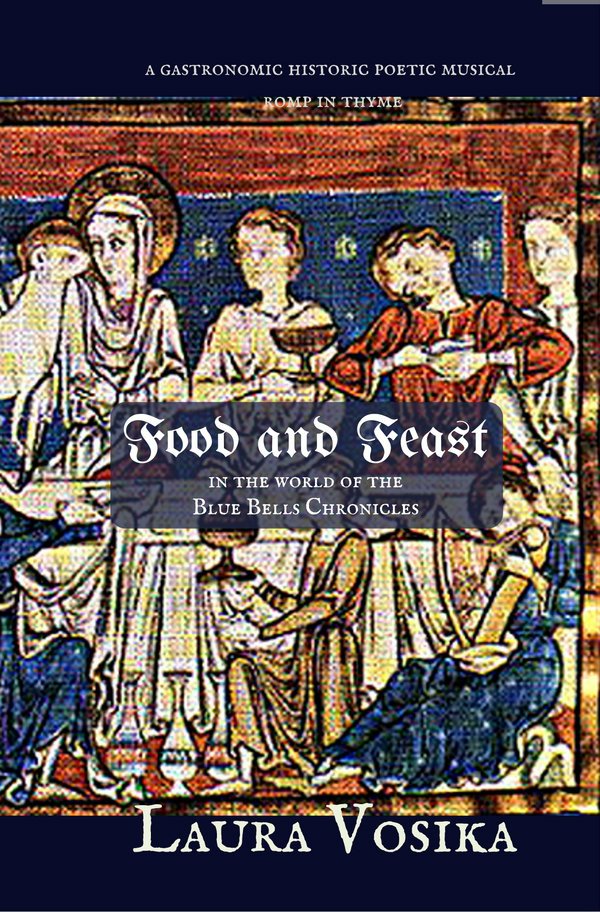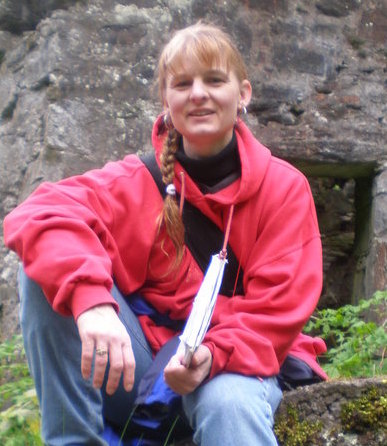FOOD AND FEAST is a light-hearted culinary adventure offering a delightful taste of history through the foods, music and wisdom of the medieval table. While the book is the table companion to The Blue Bells of Scotland novels, it also serves as a stand-alone for anyone who wants to “simply” spice up their recipe repertoire while enjoying entertaining --- and sage --- bites on the chivalry, wisdom and historical significance of the Middle Ages.
While I researched and published recipes in both medieval and modern forms, this is not a cookbook. Inspired by my love of history, my classical music background and a passion for storytelling, I hoped to offer a fun glimpse of history and ourselves by examining what is at the center of every culture since the beginning of time --- food, family and faith, story and song --- all of which are common themes in my books (BLUE BELLS OF SCOTLAND, THE MINSTREL BOY, THE WATER IS WIDE, WESTERING HOME, and THE BATTLE IS O'ER, due in late 2017). Set in medieval and modern Scotland, the novels tell the story of two men who switch places in time --- offering readers of all genres a time-travel tale filled with mystery, miracles, romance and redemption.
FOOD AND FEAST includes over 200 recipes --- Scottish, medieval and occasionally modern recipes from Midwest America. A selection of "survival" recipes reflect how the Blue Bells' main characters, Shawn and Niall, ate during their travels in the wilderness or with the medieval Scottish army of James Douglas.
I was most intrigued by my research on Hildegard von Bingen, a medieval mystic, author, scientist, visionary, abbess, composer and playwright, and her ancient insights on food, diet and health. Hildegard’s thoughts on food are typical of medieval times: Entire books could be written on the health benefits of all the possible ingredients of the modern or medieval salads. And, in fact, Hildegard von Bingen wrote a book on the benefits and drawbacks of numerous foods. One example is roses and sage:
The medievals classified food by hot/cold and dry/moist, Hildegard labeled the rose cold. She recommended placing fresh-plucked rose petals on the eyes in the morning to "draw out the humor" and make them clear. Rose petals placed on ulcers likewise drew mucus from them.
“Rose and sage combined soothed wrath. A powder was made of rose petals and sage, and the powder held to the nose when one felt wrath rising. The sage soothes the anger, while the rose brings happiness.”
 The abbreviated directions of medieval "receipts" were challenging, especially translation. Readers of FOOD AND FEAST will find modern redactions of medieval recipes. In some places, I used authentic Middle English wording of the recipes.
The abbreviated directions of medieval "receipts" were challenging, especially translation. Readers of FOOD AND FEAST will find modern redactions of medieval recipes. In some places, I used authentic Middle English wording of the recipes.
An example of an original medieval recipe (from Utilis Conquinario, 14th-century England): Botere of almand melk. Tak þikke almound melk & boyle it, & as it boyleth cast yn a litel wyn or vynegre, & þan do it on a caneuas & lat þe whey renne out. & þan gadere it vp with þyn hondes & hang it vp a myle wey, & ley it after in cold water, & serue it forth
Some ingredients were common in medieval times but are unusual today (powder fort, verjuice, powder douce, almond milk): Given that "the Middle Ages" is a swath of time a thousand years wide and, even staying in Europe, still numerous countries and cultures, and given that recipes were much less likely to be written down, it’s not surprising that there are multiple versions of “powder fort” and many other ingredients from the various centuries.
In the Middle Ages, monks did a lot of experimenting with spices and herbs, creating many of the cheeses we know today --- and it’s surprising how many of our modern cheeses were known then --- although, as one historian has noted, that a cheese had the same name doesn’t mean it was exactly like what we know today. Regardless, it is likely they were at least highly similar. The list of these cheeses known to medievals is quite long. To "spice up" a boring list:
“Beaufort, camembert, comté, and brie
all were known to the medievals and me
Emmenthal, maroilles, and cottage cheese
Mozzarella and gruyére are all bound to please
Today as in those past centuries.”
While cheeses appear to have been very similar, cattle were a bit different. Today’s livestock has gone through a great deal of breeding to bring out size --- and, thus, meat. Medieval cattle were significantly smaller --- much like the famous Chillingham Cattle. This herd, living near Chillingham Castle, lives as wild cattle did centuries ago, untouched by human interference for 800 years.
I am sharing a beef stew recipe with Bookreporter.com readers (below). I hope you will savor this hearty, centuries-old dish. If you crave more, you will find an eclectic mix in FOOD AND FEAST: tasty morsels of history, succulent songs, meaty medieval philosophy, and medieval and Scottish poems, about food and drink. Here be fire-breathing roasts and live bird pies alongside oatcakes cooked on the campaign trail.
BEEF RED WINE STEW
Beef stewed in red wine is a dish that dates back many centuries.
½ cup ground almonds; ½ teaspoon clear honey; 1 cup hot water; 2 pounds stewing beef; ½ cup breadcrumbs; ¼ cup butter; 1 cup red wine; ¼ teaspoon ground cloves; 3 teaspoons sugar; ½ teaspoon pepper; ½ teaspoon allspice; 1 teaspoon ground mace 1 teaspoon salt
* Dissolve honey in hot water.
* Pour into a bowl with ground almonds
* Steep 15 to 30 minutes; strain out almonds
* Cut beef into chunks and roll them in breadcrumbs
* Fry in butter, turning until meat is browned.
* Move to a large cooking pot.
* In a separate pan add wine, cloves and sugar and stir over medium heat until sugar dissolves
* Pour this over the meat, cover with a lid and simmer 40 minutes. Do not let it dry out!
* Stir in remaining spices and almond milk
* Heat and serve.



